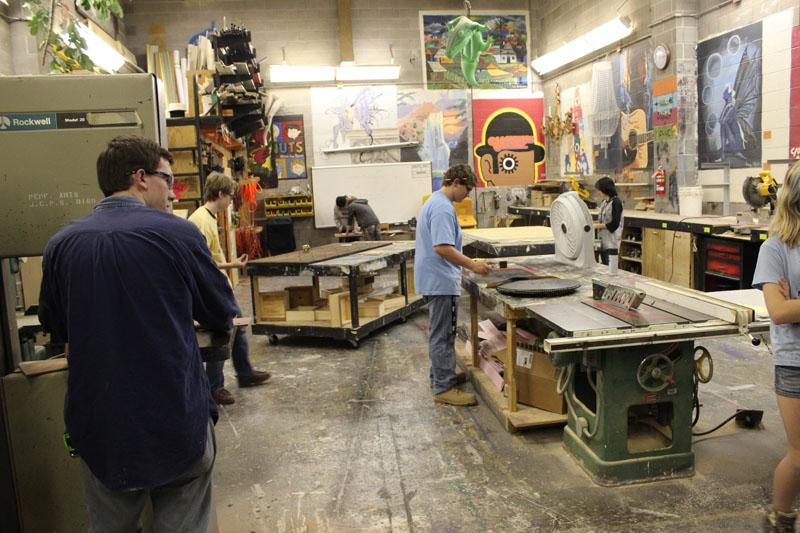The floor of the classroom was stained with spray paint used from the past few shows, and just a few students could be seen, working diligently. It didn’t seem like a regular class, and not just because it was after school. One girl was kneeling upon a table, drawing what seemed to be indistinguishable marks on a board. Another boy was cutting wood into pieces that would eventually form a circular shape. The mixed smells of cut wood and spray paint were in the air surrounding the students. Inside the room was a smaller walk-in closet filled with tools, nails, and other necessities. It wasn’t exactly a pinnacle of organization, but the show was only a few days away. Students moved in and out of the room grabbing different materials and checking to make sure everything was together, and the scene was fairly chaotic. But this was no special day—rather, it was simple routine for the average YPAS Design and Production major.
Gabrielle Lindley (12) was the propmaster for YPAS’s production of Macbeth, which premiered Sept. 26 and runs through Sept. 29. She was focused intently on making the map for the upcoming play, one of Shakespeare’s darkest and most powerful tragedies. “I get help from other people sometimes, so it’s not so hard,” she said.
While Lindley was making the map, Matthew Rivera (11) and Michael Chandler (11) were spray-painting a studded black door to be used in one of the scenes. The set was designed by their teacher, Mr. Eric Allgeier, and D&P students worked on its construction every day up until the show began. “This is my sixth show as a carpenter. We’re basing the props on more of a mix of post-modern/gothic/renaissance era,” Rivera said.
Master Carpenter Megan Fuller (12) had other roles than just making the set; she has a part in the show. “I work the trap door underneath the stage, so I don’t really get to see it all until we strike the stage [take everything down]. It’s sad because it’s all over after the last show,” Fuller said.
Downstairs, below the students’ setbuilding workspace, was the costume room. Fabric was thrown everywhere, sewing machines were buzzing, and mannequins blocked the walkways. On the left side, blue boxes labeled ‘Ties’ and ‘Shiny Fabric’ were stacked, forming a wall. Some were donated and some had been purchased, but all would someday be used to build costumes.
Ms. Amy Berry, the costume teacher, was dealing with one of the busiest days in costuming: dress parade, in which actors and actresses were fit to their costumes and adjusted accordingly. The parade meant all the hard work she and the students had been doing over the past month was finally ready. And while Ms. Berry was busy on stage, work did not stop downstairs. Jonna Hogen (12) kept the class going, making sure everyone was on task.
According to Lindley, a lot goes into the making of each show. There are three different areas in which the students rotate: lighting, costume, and scenery, each with different levels. (Seniors are the exception, spending their time on their own independent study). “We rotate every two plays, and when you do, you do interviews [with D&P teachers]. You dress up, you show them your work and what you can do, like a real job,” Kendra Malone (11) said. Not everyone outside of D&P understands the complexity of what it takes to set up a show and be active in the magnet. “I sometimes feel that people don’t know we’re here. They think we just sweep and clean, but there’s a lot of preparation that goes into it,” Lindley said.
“When people think of YPAS, they don’t usually think of D&P,” Elizabeth Markert (9) said.
On average, a D&P after-school workday starts at 2:30 every day and ends around 5:30, though it’s not unheard of for students to stay until 9:00. In classes during the school day, students learn about various elements of design and production. “You have to learn many new things; I learned about lighting, as in from the sun to spotlights,” Malone said. From lighting to safety to sewing to make-up, new opportunities are constantly available to D&P students.
As Rivera and Chandler finished spray painting, Lindley added some last touches to her map, and Malone picked out the fabrics to be used, each was contributing to a finished product that they hoped students, parents, and lovers of all kinds of art would enjoy, whether they knew who was behind it or not.
Photos by Mesa Serikali




